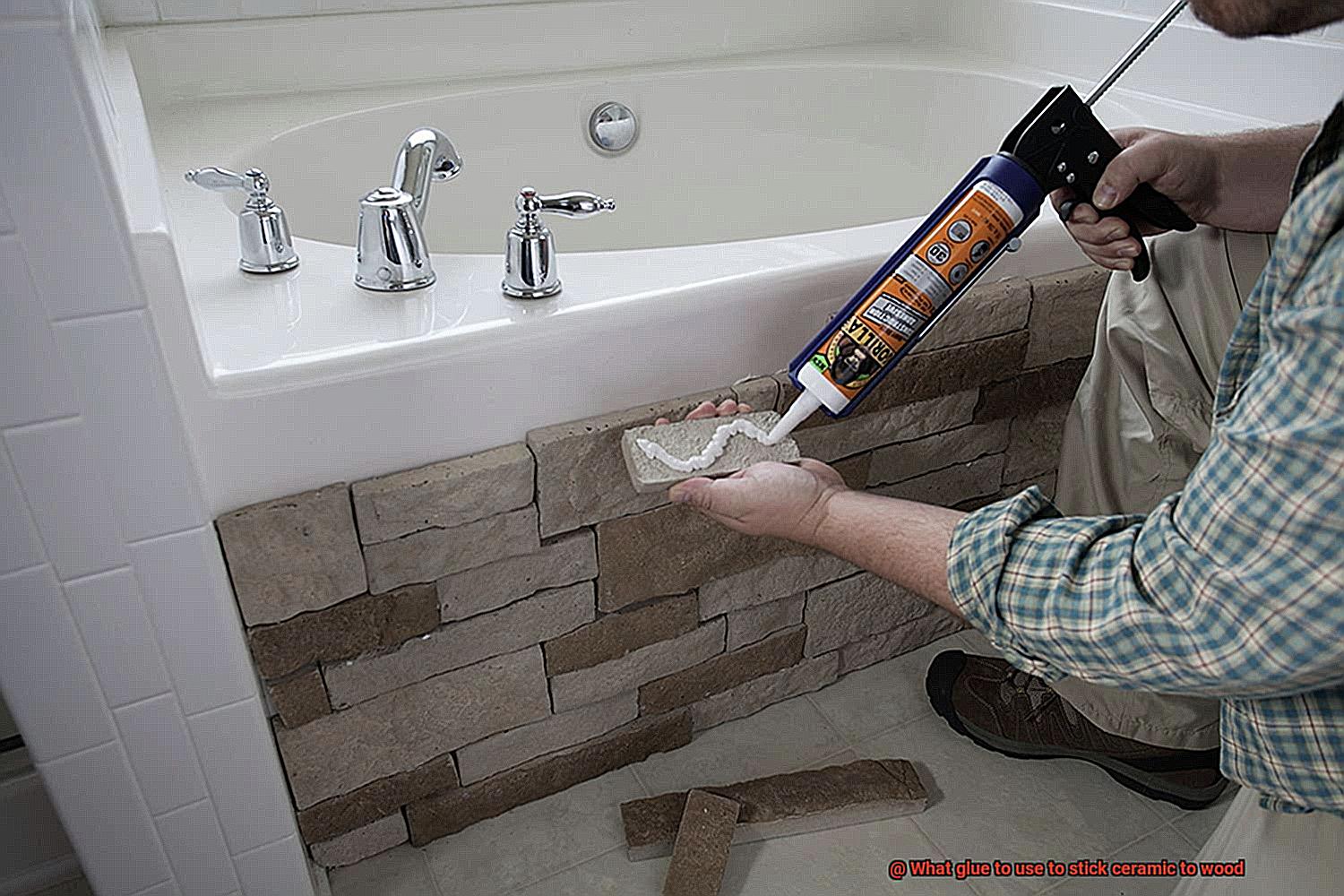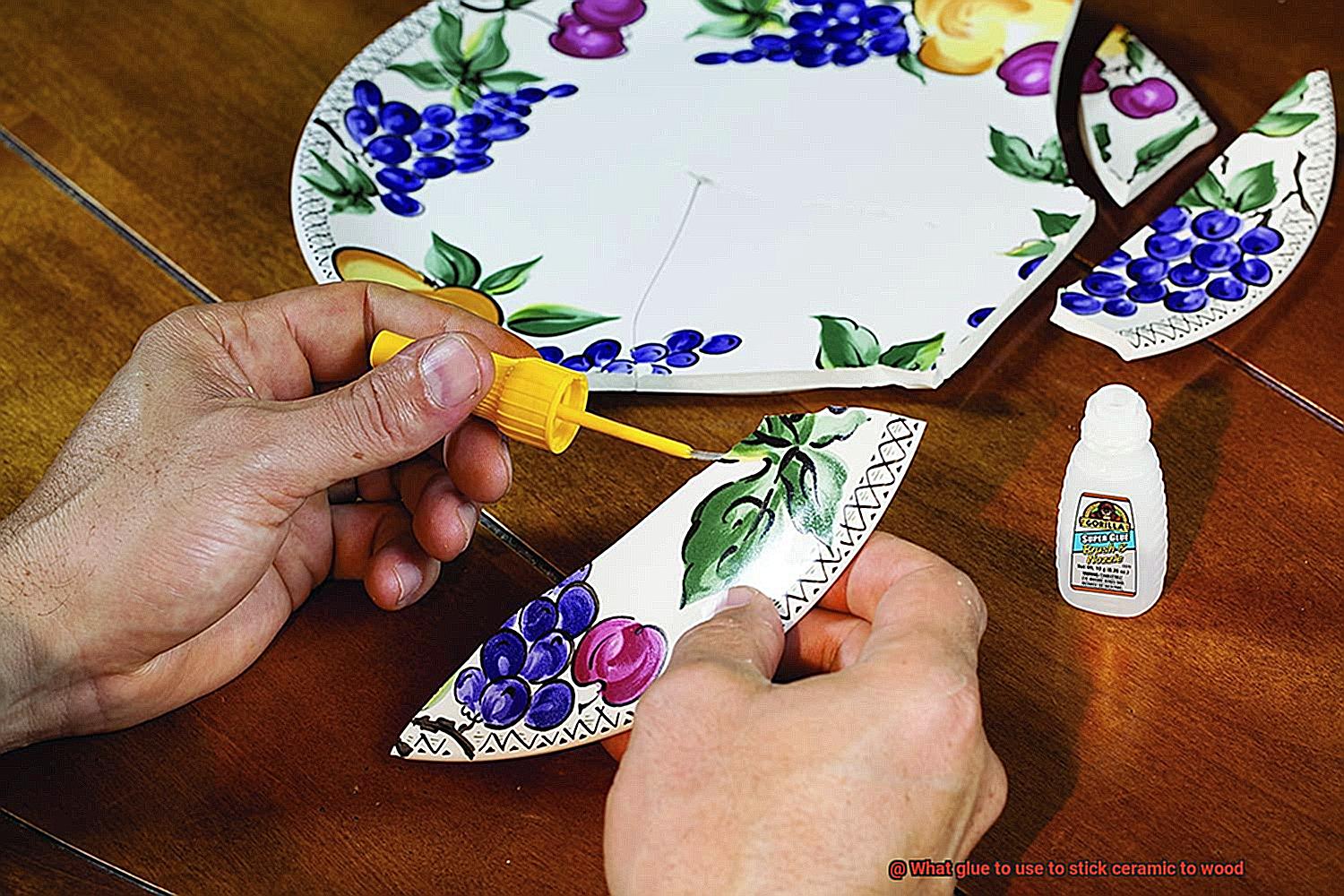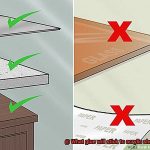Imagine this: you have a breathtaking ceramic tile that holds sentimental value or a meticulously crafted wooden masterpiece that deserves to be showcased. And now, you’re faced with the burning question: how can these two contrasting materials be flawlessly and securely united? Fear not, my friend, for we have the magical solution in the form of adhesive wonders.
Welcome to an enchanting journey into the realm of bonding ceramics to wood. Today, we’ll dive deep into this sticky matter and uncover the ultimate glue that will seamlessly bring together these magnificent elements.
On our quest for the Holy Grail of ceramic-to-wood adhesion, we’ll explore a range of options, each with its own strengths and weaknesses. From tried-and-true classics to cutting-edge innovations, we’ll decode the golden formula that guarantees a lasting union between these two materials.
Get ready to discover the key properties that make a glue perfect for this task. We’ll discuss factors like drying time, flexibility, and most importantly, its ability to withstand the test of time against moisture and temperature fluctuations.
Throughout this virtual expedition, you’ll gain valuable insights on renowned contenders such as epoxy resin, polyurethane adhesive, cyanoacrylate glue, and even the wonders of silicone-based products. Armed with this newfound knowledge, you’ll confidently choose the ideal adhesive tailored to your specific needs.
So buckle up and brace yourself for an exhilarating adhesive adventure. Let your creative spirit soar as we unlock the secrets behind creating impeccable ceramic-to-wood bonds that will endure throughout ages.
Types of Glues for Ceramic and Wood
Contents
Choosing the right glue is crucial when it comes to bonding ceramic and wood. Each type of glue has its own unique characteristics, advantages, and disadvantages. In this article, we will delve into the different types of glues that can be used for this purpose and equip you with the knowledge to make an informed decision.
Epoxy Glue – The Indomitable Bond:

Epoxy glue reigns supreme as a popular choice for bonding ceramic to wood. Its strength and durability are unmatched, making it capable of withstanding high temperatures and moisture. This two-part adhesive requires precise mixing of the resin and hardener before application. Once applied, epoxy glue dries clear and hard, rendering it suitable for both indoor and outdoor use. However, its strong odor and meticulous mixing ratios can pose challenges during application.
Polyurethane Glue – The Versatile Warrior:
Polyurethane glue stands tall as another exceptional option for bonding ceramic and wood. Renowned for its versatility and robust bonding strength, this adhesive expands as it cures, effectively filling gaps and creating a solid bond. Furthermore, polyurethane glue is water-resistant, making it ideal for outdoor applications. It is worth noting that clamping is necessary during the curing process, which may take longer compared to other glues.
Cyanoacrylate Glue – The Instant Fixer:
When time is of the essence, cyanoacrylate glue, commonly known as super glue, comes to the rescue. Its quick-drying nature allows for an instant bond between ceramic and wood surfaces. Super glue excels in small-scale projects, providing a strong hold. However, it may not be suitable for larger or heavier ceramic pieces due to its limited strength over time.
Silicone Adhesive – The Flexible Companion:
Silicone adhesive offers unparalleled flexibility and a robust bond between ceramic and wood. Its ability to withstand temperature changes and moisture makes it an excellent choice for both indoor and outdoor applications. Silicone adhesive is often employed in projects requiring movement or flexibility, such as attaching ceramic tiles to wooden surfaces. Nevertheless, it may not provide as strong of a bond as epoxy or polyurethane glues, particularly on smooth surfaces.
Specialized Ceramic Glues – The Experts’ Choice:
For those seeking the crème de la crème of ceramic-to-wood adhesives, specialized ceramic glues are the experts’ choice. These glues are specifically formulated to provide a strong bond while also exhibiting resistance to moisture and temperature changes. It is imperative to carefully follow the manufacturer’s instructions when using these specialized ceramic glues for optimum results.
Advantages and Disadvantages of Epoxy Resin
Welcome, adhesive aficionados. Join us once again as we embark on a thrilling journey through the world of glues and discover the perfect companion for your ceramic and wood fusion projects. Today, let’s delve into the pros and cons of using epoxy resin in this enchanting bonding adventure. Fasten your seatbelts.
Advantages of Epoxy Resin:
- Strong Bonding: Imagine a bond that defies all odds, withstanding the test of time and stress. Epoxy resin is the hero you’re looking for. Its exceptional bonding strength forms an unbreakable connection between ceramic and wood, ensuring durability and longevity. It’s like having a super glue by your side.
- Versatility: In the realm of adhesives, versatility reigns supreme. And epoxy resin proudly wears the crown. This adhesive prodigy effortlessly bonds a wide range of materials, including our beloved ceramic and wood. It doesn’t discriminate between porous or non-porous surfaces, making it the ultimate choice for any application. Prepare to break boundaries with epoxy resin.
- Water Resistance: Don’t let water dampen your creative spirit. Epoxy resin boasts excellent resistance to water and moisture. When properly applied, it creates a waterproof barrier between ceramic and wood, safeguarding them from damage or degradation caused by water exposure. Say goodbye to water woes with epoxy resin.
- Temperature Resistance: Some projects demand heat endurance – be it scorching hot conditions or rapid temperature fluctuations. Fear not. Epoxy resin rises to the challenge with its remarkable temperature resistance. It can withstand high temperatures, ensuring your bond remains strong and unyielding under any thermal conditions. Let epoxy resin handle the heat while you focus on creating masterpieces.
Now, let’s flip the coin and explore the potential drawbacks of using epoxy resin for ceramic-wood bonding. Brace yourselves.
Disadvantages of Epoxy Resin:
Mixing and Application: Ah, the delicate art of mixing. Epoxy resin requires precise blending of two components – the resin and the hardener – in the correct proportions. It demands your attention, like a dance that must be choreographed flawlessly.
Benefits of Polyurethane Adhesive
First and foremost, let’s talk about the incredible bonding strength of polyurethane adhesive. This superhero adhesive forms a bond so powerful between ceramic and wood that it might as well be considered unbreakable. Say goodbye to worries about your ceramic tiles or objects detaching from the wooden surface because polyurethane adhesive has got your back.
But hold on tight, because there’s more to this adhesive wonder. Polyurethane adhesive is also incredibly flexible, allowing for some movement between the ceramic and wood surfaces. You know those pesky temperature and humidity changes that cause materials to expand and contract? Well, fret not because polyurethane adhesive can handle it like a boss. Its flexibility absorbs any stress or movement, reducing the risk of unsightly cracks or frustrating breaks.
Now, let’s dive into the realm of water resistance. When you’re bonding ceramic to wood, encountering water is practically inevitable, especially in areas like bathrooms or kitchens. But fear not. Polyurethane adhesive steps in as the hero you need. With its excellent water resistance properties, it acts as an impenetrable barrier against moisture, keeping your bond strong and preventing any water damage.
Durability is another superpower possessed by polyurethane adhesive. Once cured, this adhesive forms a tough and resilient bond that can withstand any environmental conditions and everyday wear and tear. So go ahead and place your trust in polyurethane adhesive when bonding ceramic objects to wood surfaces that will see frequent use or heavy loads.
And don’t think for a second that the wonders of polyurethane adhesive end there. This remarkable adhesive isn’t limited to just bonding ceramic to wood. Oh no, it’s a versatile genius that can also bond other materials like metal, plastic, and glass. Talk about being a jack of all trades.
In conclusion, polyurethane adhesive is the ultimate sidekick when it comes to bonding ceramic to wood. Its unbeatable bonding strength, flexibility, water resistance, durability, and versatility make it the clear choice for this specific application. Say goodbye to weak bonds and hello to a secure connection that will stand the test of time.
Super Glue: Pros and Cons
Today, we’re going to explore the pros and cons of using this powerful adhesive for bonding ceramic to wood. So strap on your safety goggles and prepare to get sticky.
Let’s kick things off with the pros. Super glue, also known as cyanoacrylate adhesive, is a favorite choice among DIYers for a reason. First off, it dries in a flash. In just seconds to minutes, you can achieve a secure bond between your ceramic and wood surfaces. Talk about efficiency.
But that’s not all – super glue packs a punch when it comes to strength. It forms an unbreakable connection that can withstand everyday wear and tear. Whether you’re fixing a wooden figurine or attaching ceramic tiles, this adhesive won’t let you down.
Versatility is another ace up super glue’s sleeve. It works wonders on various materials, from delicate porcelain to sturdy oak. So no matter what combination of ceramic and wood you’re working with, super glue has got you covered.
And let’s not forget how accessible and affordable super glue is. You can find it at your local hardware store or order it online without breaking the bank. Convenience at its finest.
Now, let’s dive into the cons. While super glue offers many benefits, it does come with a few limitations. First off, it lacks flexibility once cured. This means that under stress or movement, it can crack or break. So if you need something that requires flexibility, like a wooden joint that needs to move, super glue may not be the right choice.
Size matters too – super glue may not be suitable for larger or heavier ceramic pieces. Its strength may not be enough to securely hold them in place. So if you’re working with a massive ceramic vase or sculpture, you might want to explore other adhesive options.
It’s also important to remember that not all super glues are created equal. Some brands have stronger bonding properties than others, so it’s crucial to choose a high-quality product for optimal results.
Another potential drawback is the messy nature of super glue application. Given its fast-drying nature, precision is key to avoid accidental spills or excess adhesive. So keep those steady hands ready.
Last but certainly not least, removing super glue can be quite the challenge. Its strong bond makes it difficult to remove without potentially damaging the ceramic or wood surfaces.
Specialized Ceramic Glues
In our previous section, we explored the mighty super glue and its remarkable ability to bond ceramic to wood. However, we also discovered some limitations that come with this superhero adhesive.
But fret not, because today we’re diving into the world of specialized ceramic glues. These glues are specifically formulated to conquer the challenges of bonding ceramic materials to various surfaces, including wood.
So, let’s unveil the different types of specialized ceramic glues, their advantages and precautions, and how to use them correctly.

Epoxy Adhesive:
First up on our journey is the powerful epoxy adhesive – the titan of ceramic to wood bonding. Formulated with precision, this glue unleashes an unmatched bond between these two materials. Here’s what you need to know:
Advantages:
- Unyielding strength and durability that withstands the unique properties and challenges of ceramic materials.
- A reliable bond that ensures ceramics stay seamlessly attached to wood.
- Suitable for both small and larger pieces, making it versatile for any project.
Disadvantages:
- Requires careful mixing of the resin and hardener, but don’t worry, it’s a small price to pay for perfection.
- Some epoxy adhesives may require additional steps like primer or surface preparation, ensuring a bond that stands the test of time.
- Patience is key as epoxy adhesives have a longer curing time compared to other glues. But remember, good things come to those who wait.
Cyanoacrylate Adhesive (Super Glue):
This fast-drying adhesive has a reputation for its strength and versatility. However, not all super glues are worthy of the task when it comes to bonding ceramic to wood. Let’s unveil the secrets of this adhesive:
Advantages:
- Speedy drying time, perfect for those quick projects where time is of the essence.
- A bond that holds strong between ceramic and wood, ensuring your creations stay intact.
- Easy application with precision, allowing you to achieve the perfect alignment.

Considerations When Choosing a Glue
Creating a strong and lasting bond between ceramic and wood requires careful consideration when selecting the right glue. With numerous options available, it’s essential to understand the factors that contribute to a successful adhesive connection. As an expert in this field, I am here to guide you through the considerations you need to keep in mind when choosing the perfect glue for your ceramic and wood project.
Adhesive strength:
The foundation of a sturdy bond lies in the adhesive strength of the glue. Ceramic’s smooth and non-porous surface paired with wood’s porous nature necessitates a glue specifically formulated for bonding these two materials. Look for glues that proudly declare their ability to create a robust bond between ceramic and wood.
Waterproof or water-resistant:
Consider the intended use of your ceramic and wood combination. If it will be exposed to moisture or used in wet environments, such as outdoor furniture or bathroom tiles, selecting a glue that is waterproof or water-resistant is paramount. This ensures the longevity of the bond, even in the face of constant exposure to water.
Drying time:
Time is of the essence in any project, so take into account the drying time required by the glue you choose. Some glues dry within minutes, enabling swift progress, while others may require several hours or even days to fully cure. Aligning the drying time with your project timeline guarantees efficiency and convenience.
Flexibility:
Wood’s tendency to expand and contract with changes in temperature and humidity calls for a flexible glue that can withstand these movements without compromising the bond. Opt for flexible glues, such as epoxy or polyurethane adhesives, known for their ability to accommodate these changes without cracking or breaking.
Temperature resistance:
If your ceramic and wood combination will be exposed to high temperatures, like near stoves or fireplaces, it’s crucial to choose a glue that can withstand these conditions. Select a heat-resistant glue that won’t weaken or melt under intense heat, ensuring the bond remains secure even in extreme temperature environments.
Ease of application:
Simplicity is key when it comes to applying glue. Consider your level of experience and comfort with adhesives. Look for glues that come in convenient applicator bottles or tubes, providing ease of use even for beginners. Avoid complex mixing or application processes unless you are confident in your abilities.
Tips for Applying the Glue Properly

Are you about to embark on a creative project that involves bonding ceramic and wood surfaces? To ensure a successful outcome, it’s crucial to apply the glue properly. By following these expert tips, you can create a strong and durable bond that will stand the test of time. Let’s dive in.
Start with Immaculate Surfaces:
Before applying any glue, take the time to clean both the ceramic and wood surfaces meticulously. Bid farewell to dirt, dust, and grease by using a mild detergent or rubbing alcohol. For the wood surface, gently sand it to create an ideal bonding surface that will promote adhesion.
Strike the Perfect Balance:
The key to a successful bond lies in using the right amount of glue. Applying too little may result in a weak connection, while applying excess can create unsightly and messy glue lines. Follow the manufacturer’s instructions to strike the perfect balance and achieve a flawless bond.
Harness the Power of Pressure:
Once the glue is applied, it’s time to exert even pressure on both the ceramic and wood surfaces. This can be achieved by employing clamps or strategically placing weights to hold them together firmly. Remember, an even distribution of clamps along the glued area is essential for uniform pressure application.
Patience is a Virtue:
Different glues have different drying times, so it’s imperative to exercise patience during this crucial step. Rushing the drying process can compromise the bond’s strength. To ensure maximum durability, allow the glue to dry for at least 24 hours before subjecting the glued object to any stress or pressure.
Opt for Superb Adhesives:
When it comes to bonding ceramics and wood, epoxy or polyurethane glues are your allies in achieving exceptional results. These glues possess remarkable adhesive properties, including excellent gap-filling abilities and resistance to moisture, heat, and other environmental factors. Choose these glues for long-lasting bonds that will endure the test of time.
Test, Test, Test:
Before committing to the final application, it’s wise to conduct a test run. Glue together a small piece of ceramic and wood and subject it to various stressors to evaluate the bond’s strength. This step ensures that the glue adheres well and produces the desired outcome, setting the stage for success.
qrNu0g_zC74″ >
Conclusion
When it comes to bonding ceramic to wood, choosing the right glue is crucial.
You need a strong adhesive that can withstand the test of time and ensure a secure bond between these two materials. One excellent option is epoxy glue, which is known for its exceptional strength and durability.
Epoxy forms a tough and resilient bond that can withstand both moisture and temperature fluctuations, making it ideal for ceramic-to-wood applications. Another reliable choice is polyurethane adhesive, which offers excellent bonding properties and flexibility.
This type of glue expands as it cures, filling in any gaps or irregularities between the ceramic and wood surfaces. It creates a strong and long-lasting bond that can handle the stresses of everyday use.
Additionally, cyanoacrylate adhesive, commonly known as super glue, can also be used to attach ceramic to wood. Super glue provides instant bonding and dries clear, ensuring an aesthetically pleasing result.
However, keep in mind that super glue may not be as durable as epoxy or polyurethane adhesives in terms of long-term performance. Before applying any adhesive, make sure to clean the surfaces thoroughly and roughen them slightly with sandpaper for better adhesion.
Always follow the manufacturer’s instructions when using any type of glue to achieve optimal results.






